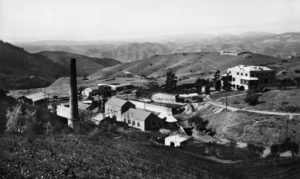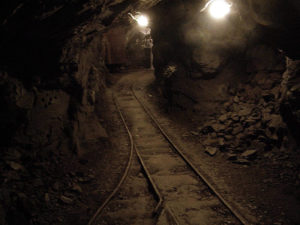We propose a series of activities to do with family or friends and combine it with your beach vacation. Our goal is to present the most unkown environment inside the Costa Daurada by the majority in order to discover the cultural, landscape and natural heritage of this magnificent place and promote outdoors activities. Priorat region offers an important and very interesting range of proposals throughout the year.
Undoubtedly, one of the most liked children is a visit to the Museum of the Mines of Bellmunt del Priorat, opened in 2002 and located in the industrial complex of the Eugenia Mine, at the foot of the “Turó of Sarrai” 400 meters the municipality of Bellmunt and a few kilometers from Falset, the capital of the region. This mining-metallurgical complex was the most important of Catalonia with regard to the extraction of galena, an ore of lead, both in quantity and quality.
According to several authors, extraction in this region dates back to prehistoric times between the second part of the Neolithic period, 3000 BC, and eneolítica civilization, 2000 BC. During the Middle Ages (XIV century) mining in the Priorat it was consolidated according to the documentation that is available, and relations between the municipality of Falset and the island of Sardinia, favored the incorporation of new exploitation techniques, such as mechanical means (waterwheels) for water extraction and mineral, machinery for crushing moved by hydraulic or animal power and fire to produce oscillations in temperature as well as contractions and dilations that would just cracked the too hard rock.
During the XVI and XVII centuries, the galena was mined from surface lodes and was used to make ceramics and metallic reflections, weights for scales, like other objects of great weight and low volume. These farms paid tribute to the Charterhouse of Escaladei, owner of the land from 1313 to 1820. Other mines around 1750 and close to Mina Eugenia, were incorporated into the crown, so are known as “Minas del Rei”. Although from 1868, mining properties were transferred to private parties under the concession system. The history of Mina Eugenia begins in 1893 when a farmer found a lot of galena, but the crisis of phylloxera makes sell the land to a Belgian company. In the early XX century these mines passed into the hands of private Catalan capital.
The period of greatest activity occurred between the 1920s and 1960s, which was reflected in the increase in population of the municipality, establishing a mining colony with  a way of being and living. Many of the mine workers exercised agricultural activities for family support, both in their own land and working as laborers.
a way of being and living. Many of the mine workers exercised agricultural activities for family support, both in their own land and working as laborers.
Outside of Mina Eugenia are still preserved remains of the associated mining and mineral processing industry as well as the foundry for lead ingots. We can observe the chimneys and the castles installed at the main wells and walk around the surface where mineral slags were stored . The interior is formed by a network of galleries that occupy more than 50 km long and in some cases reaches 620m deep.
We can walk along a stretch of the first gallery that opened in the nineteenth century, with a prepared tour guide to 35 m deep and with a distance of 700 m., accessed through the emergency exit of former miners. Then we will see replicas of miners working and visit an exhibition in the old workshops where the metal was processed.
The mining set consists of the production area, where the mine and buildings extraction and treatment of mineral was. The most commom system was exploitation galleries connected through vertical wells. There is a network of about 14kms long and a total of 20 underground floors. On the outside, there was the building of the castle extraction, the engine room, boiler room, the building crushing, laundry, smelting and conducting smoke stacks and workshops. There was also the “Casa de las Minas”, the building of the company Minas del Priorato, S.A., 1905 modernist style and destined to residence address, offices and laboratory of the company. Finally, towards the 20s, one of the best stages of growth, the company is building a housing to house the workforce coming from other mining areas of Spain. Among workers certain differences were established according to the origin of immigration, for status inside or outside of the mine. Local workers were carrying out tasks like foundry, workshops or administration since they possessed land to cultivate, thus combining the two tasks. The mining colony had a facility available for workers with basic products at more affordable prices: the commissary, very important and valued especially in the postwar years, where commodities were in short supply.
Two very significant events of the technological revolution in mineral extraction were: the use of electric current as the driving force to move the castle, which moves the steam engine. 1921 electricity comes from Reus; the second, the installation of compressors for the use of compressed air hammers (from the 40s) significantly increased productivity of extraction.
The mining and metallurgical group was active until the end of 1972.
Schedule:
From 1st of July to 31st of August:
Tuesday to Saturday: 11:00 h to 13:00 h and 17:00 h to 19:00 h
Sundays and fetivos: 11:00 h to 13:00 h
From 1st of September to 30th of June:
Saturday: 11:00 am to 13:00 pm and from 16:00 to 18:00 h (guided tour at 16:30 h)
Sundays and public holidays from 11:00 h to 13:00 h
Tuesday through Friday by appointment
Prices: entry into the museum’s tour 7 Euro, general admission 3 Euro, 2 Euros discount for people over 65, under 16 and free admission for children under 8 years.






Leave a Comment
You must be logged in to post a comment.